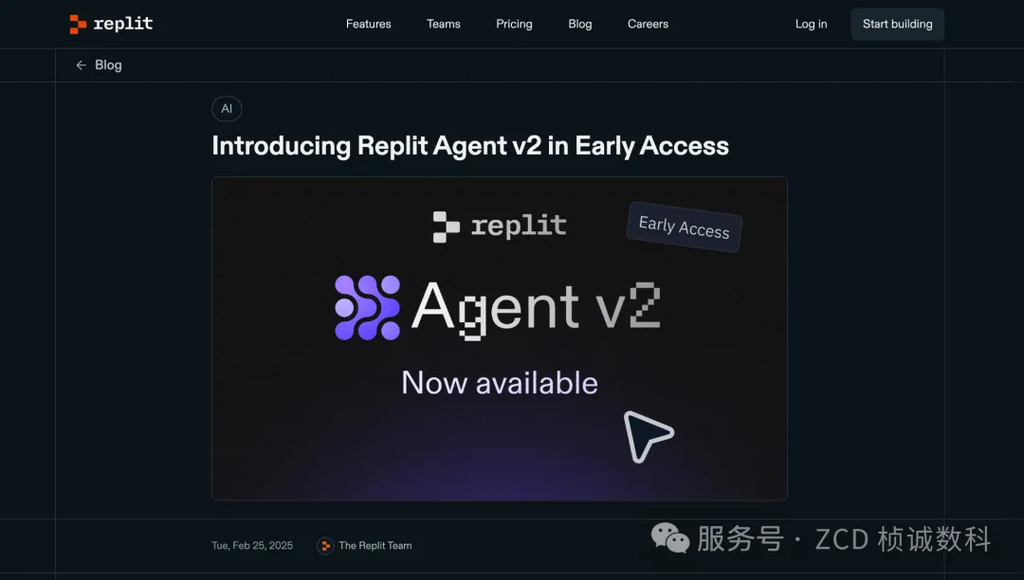Google’s “Sibling” Isomorphic Labs Secures Major Funding / Rumored $45B xAI “Merger” with X / OpenAI Faces Compute Shortage, Potentially Delaying New Products
📌 Table of Contents:
- 💰 Google’s “Sibling” Isomorphic Labs Secures Major Funding
- Rumor: xAI’s $45 Billion “Merger” with X
- A New Dawn for AI Psychotherapy?
- Sesame Voice Robot Achieves Personalized Calls and Memory
- Replit AI Agent V2 Boosts Application Development Autonomy 10x!
- OpenAI Compute Shortage May Delay New Product Launches
- Amazon Unveils AI Agent: Nova Act Challenges OpenAI
- Nvidia Launches AI Assistant G-Assist
PART 01: Google’s “Sibling” Isomorphic Labs Secures Major Funding

What are the highlights?
Isomorphic Labs, a Google subsidiary famous for its Nobel Prize-level protein structure prediction technology AlphaFold, has secured up to $600 million in funding. This capital will be used to collaborate with pharmaceutical giants like Eli Lilly to develop more advanced AI models for drug design. Its ultimate goal is incredibly ambitious – “to one day solve all diseases with AI,” showcasing AI’s immense potential to reshape the future of medicine. This investment highlights the confidence of the tech and pharmaceutical industries in AI’s revolutionary potential to accelerate drug discovery.
What can practitioners think about?
- Practitioners: Pharmaceutical companies need to accelerate embracing AI collaborations and internal investments; AI researchers (especially in machine learning, computational biology) face golden opportunities; traditional drug scientists need to learn to collaborate with AI systems and master interdisciplinary knowledge.
- Public: Hope for faster access to new therapies for intractable diseases, improving health and extending lifespan. Increased drug development efficiency may also lower the cost of new drugs. However, a rational perspective is needed; AI drug discovery is still in its early stages, and challenges remain.
Access Method
- Related Link: https://www.isomorphiclabs.com/
PART 02: Rumor: xAI’s $45 Billion “Merger” with X

PART.01: What are the highlights?
According to reports, Elon Musk’s AI startup xAI has acquired his social media platform X (formerly Twitter) for a staggering $45 billion, with the merged entity valued at $113 billion. This move aims to deeply integrate the two companies’ “data, models, compute power, distribution, and talent,” combining xAI’s “Colossus” supercomputer with X’s massive user base of approximately 650 million to build a vertically integrated AI and social media empire.
PART.02: What can practitioners think about?
- Practitioners: May intensify competition in the AI (especially large models, personalized AI) and social media industries; X platform might see major AI-driven innovations (e.g., content moderation, recommendation algorithms); creates new opportunities for data scientists and AI engineers.
- Public: X users might experience more personalized and intelligent social features in the future, but it could also raise concerns about data concentration, privacy, security, and the potential influence of algorithms. Trust and transparency will be key.
- Related Link: https://www.washingtonpost.com/technology/2025/04/01/elon-musk-xai-buys-x-merger/
PART 03: A New Dawn for AI Psychotherapy?

PART.01: What are the highlights?
A groundbreaking study from Dartmouth College found that a large language model (LLM) named “Therabot,” specifically trained in therapy techniques, was as effective as human therapist-led Cognitive Behavioral Therapy (CBT) in reducing symptoms of depression (by 51%) and anxiety (by 31%). This marks a significant potential for AI in meeting the growing demand for mental health support.
PART.02: What can practitioners think about?
- Practitioners: Mental health professionals might view AI as an auxiliary tool but also need to consider the evolution of their own roles; AI researchers have new directions for developing more empathetic, personalized mental health models; healthcare administrators need to explore the integration, regulation, and ethical frameworks for AI therapies.
- Public: AI promises more accessible, private, and lower-cost mental health support options, benefiting underserved populations. However, concerns about the lack of human warmth, data privacy, etc., need attention. More research is still required to validate long-term effectiveness and safety.
- Related Link: https://home.dartmouth.edu/news/2025/03/first-therapy-chatbot-trial-yields-mental-health-benefits#:~:text=Dartmouth%20researchers%20conducted%20the%20first,March%2027%20in%20NEJM%20AI.
PART 04: Sesame Voice Robot Achieves Personalized Calls and Memory

PART.01: What are the highlights?
Sesame, a company that gained popularity for its ultra-realistic voice synthesis, has taken another step forward by introducing a new feature: users can log in and have conversations up to 30 minutes long with its virtual avatar. A more crucial innovation is the introduction of “cross-device shared memory,” allowing the AI to remember previous conversations and user preferences, providing a persistent and personalized interaction experience, moving closer to a more natural AI companion.
PART.02: What can practitioners think about?
- Practitioners: Provides new ideas for AI developers in advanced speech synthesis, natural language understanding, and memory management; could have profound impacts on customer service and virtual assistant industries; sparks in-depth discussions on human-computer interaction design, emotional connection, and ethical boundaries.
- Public: Can experience more immersive, coherent, and understanding AI interactions, potentially used for companionship, entertainment, or information retrieval. But as AI becomes increasingly “human-like,” attention must be paid to blurring human-machine boundaries, data privacy, and other potential issues.
PART 05: Replit AI Agent V2 Boosts Application Development Autonomy 10x!

PART.01: What are the highlights?
Replit, an AI platform dedicated to simplifying application development, has released its significantly upgraded AI Agent v2 model. Compared to the previous version, the new model boasts a 10x increase in autonomy in helping users build applications and a 5x improvement in success rate, greatly lowering the barrier to software development. It is now available to all users.
PART.02: What can practitioners think about?
- Practitioners: Software developers can leverage such tools to automate repetitive tasks, generate code, assist debugging, significantly boosting efficiency; tech entrepreneurs can turn ideas into reality at lower costs and faster speeds; drives research in AI for code generation and program synthesis.
- Public: Enables people with limited or no programming experience to create custom applications, fostering mass innovation; the overall increase in software development efficiency may eventually lead to faster and better application iterations.
- Related Link: https://blog.replit.com/agent-v2
PART 06: OpenAI Compute Shortage May Delay New Product Launches

PART.01: What are the highlights?
OpenAI CEO Sam Altman admitted that due to the unexpected popularity of the image generation feature in its GPT-4o model, the company is facing a severe compute (computing resource) bottleneck. This shortage could not only delay the release of undisclosed new products but might even affect the speed of existing services like ChatGPT. Altman even half-jokingly called for anyone with 100,000 GPUs to contact OpenAI, highlighting the massive resources required to support cutting-edge AI research.
PART.02: What can practitioners think about?
- Practitioners: Highlights the critical importance of accessing high-performance computing resources for AI R&D, stimulating demand for more efficient algorithms and hardware solutions; benefits cloud service providers (like AWS, Azure, Google Cloud) and GPU manufacturers (like Nvidia); underscores the investment value of AI infrastructure.
- Public: Users might experience delays in OpenAI’s new feature releases, and existing services could potentially slow down; this informs the public about the infrastructure costs required to drive advanced AI; requires realistic expectations about the pace of AI technology adoption.
PART 07: Amazon Unveils AI Agent: Nova Act Challenges OpenAI

PART.01: What are the highlights?
Amazon officially released its general-purpose AI agent “Nova Act,” currently in research preview. This AI can autonomously navigate and control web browsers, collecting and analyzing web content and performing various online tasks for users. Amazon plans to integrate it with its voice assistant Alexa+. Notably, Amazon claims that in internal benchmark tests (ScreenSpot Web Text), Nova Act (94%) outperformed OpenAI’s CUA (88%) and Anthropic’s Claude 3.7 Sonnet (90%). The project was developed by Amazon’s AGI lab in San Francisco (led by former OpenAI researchers).
PART.02: What can practitioners think about?
- Practitioners: AI developers will closely watch Nova Act’s technical implementation; Web developers need to consider how to make websites interact better with AI agents; could potentially disrupt the market for existing productivity tools that rely on manual web operations.
- Public: Promises to greatly simplify daily online operations, automate tedious web tasks, saving time and effort; integration with Alexa+ could bring a smoother voice-controlled web experience. However, concerns about privacy and security risks associated with authorizing AI to control browsers also need attention.
- Related Link: https://labs.amazon.science/blog/nova-act
PART 08: Nvidia Launches AI Assistant G-Assist

PART.01: What are the highlights?
Graphics Processing Unit (GPU) leader Nvidia has released Project G-Assist, an AI assistant designed specifically for users of its RTX series GPUs. This real-time assistant can intelligently optimize game settings for peak performance, accurately measure game frame rates, and even control connected accessory lighting effects, enhancing the PC gaming experience across the board.
PART.02: What can practitioners think about?
- Practitioners: Game developers may need to consider how to make their games cooperate better with such AI assistant optimizations; might prompt other hardware manufacturers to follow suit, integrating AI features into their products; third-party developers might have opportunities to create plugins that interact with G-Assist.
- Public: RTX graphics card users can enjoy smoother gameplay with potentially better visuals through AI auto-optimization, without tedious manual tuning; real-time frame rate monitoring helps understand system performance; lighting control adds personalized ambiance.
- Related Link: https://www.nvidia.com/en-us/geforce/news/g-assist-ai-companion-for-rtx-ai-pcs/
AI Tech News Daily Summary
Today’s AI landscape is filled with rapid innovation and grand visions. From revolutionary breakthroughs in drug discovery and the reshaping of social media landscapes to new avenues for mental health support and empowering individuals to develop applications, AI is deeply integrating into every aspect of our lives. Although challenges like compute bottlenecks and the need for prudent governance persist, the progress showcased in today’s news clearly illustrates AI’s transformative power and its potential to create a future of infinite possibilities. As we navigate this exciting era, we need to maintain a balanced perspective, embracing innovation while proactively addressing ethical challenges to ensure AI development ultimately benefits all of humanity.
ZC Digitals (桢诚数科)
🚀 Leading enterprise digital transformation, shaping the future of industries together. We specialize in creating customized digital systems integrated with AI, achieving intelligent upgrades and deep integration of business processes. Relying on a core team with top tech backgrounds from MIT, Microsoft, etc., we help you build powerful AI-driven infrastructure, enhance efficiency, drive innovation, and achieve industry leadership.

